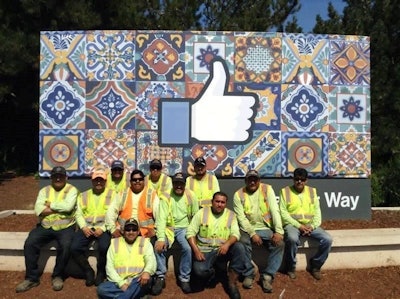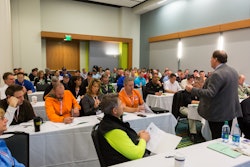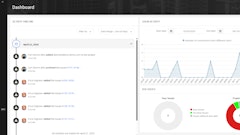
“Asphalt doesn’t need to be just rock and oil,” says Allan Henderson, president of American Asphalt Repair and resurfacing Co., Inc.
And it doesn’t take much time talking with him or reviewing his company’s marketing approach to realize just how true that is.
Direct-mail postcards that blare “FREE POT hole repair” or “FREE CRACK repair” make it clear that American Asphalt’s marketing approach is, well, a little out there. And then there’s the contractor’s homemade Road Kill Red wine.
“I know we’re different. We’re not down the middle, but it works and we can back it up with the work,” Henderson says. “Sometimes they have to hold me back with some ideas, and we’ve learned that some approaches are better for some markets than for others but on the whole it works.”
Sure does.
American Asphalt is a medium-sized paving and pavement maintenance company based in Hayward, California. “We let other people do the new construction and then we wait about five years and go back and seal it or fix it,” Henderson says.
The company serves the northern California market, from Bakersfield to the Oregon border, employing 130 people and generating $43 million in sales. Henderson says 60% of their work is for private customers and 40% is municipal work. Half of sales are paving and patching, 25% are slurry seal, 10% sealcoating, 10% concrete and 5% striping. American Asphalt runs three paving crews, two slurry surfacing crews, three sealcoating crews, three concrete crews and two striping crews.
“We’re a confident group,” Henderson says. “What we try to do with our marketing is get a one-to-one or face-to-face conversation with the customer. And we don’t just talk about asphalt, we talk about whatever. We’re not a hard sell so we don’t have to shove asphalt down their throat. We get a trust level going and that gives them a confidence level with us and hopefully they decide to give us a try. Once that happens we‘re in good shape because we back up what we say.”
High-end Driveways to Parking Lots
Henderson started on a slurry seal crew when he was 19 in Santa Rosa, CA, and eventually worked on large projects including military bases throughout the western states. After seven years the company split in two, and he stayed with the half that worked in northern California and eventually folded after several years.
So Henderson was on his own, doing high-end driveway work and he convinced three friends to invest $4000 each (he paid them 100% for each year he used their money until he could afford to buy back their stock). He worked and lived out of a camper (with a phone line connected to a nearby contractor’s office), soon saving enough money to buy a half-acre yard in Redwood City, 30 miles south of San Francisco.
In 1995 American Asphalt moved to a 2-acre facility in Hayward, and now operates out of a 4 ½-acre yard, “pretty much doubling in size each time we moved,” he says.
He continued to focus on high-end driveways in the San Francisco Bay area and eventually worked his way up to do parking lots at Oakland Coliseum, Candlestick Park and the Cow Palace among others, then eventually started pursuing and winning small city projects.
He says moving up in job size was a gradual process. “I had worked on large projects before with the other companies so I was comfortable with the scale of work,” he says. “The size of the job didn’t intimidate me.”
Even while he was working in the field Henderson took an interest in marketing – specifically what he terms “grass roots marketing.” He did some marketing on his own as time allowed but eventually hired someone to take his place on the back of the machine. “I did it so I could concentrate on sales,” Henderson says. “I switched over to sales to keep the monster fed.”
And the more involved he was in sales, the more involved he became in marketing – and he found he liked it.
Marketing to Drive Sales
“The more marketing I did, the more involved I got with it and the more I enjoyed it. And the more I realized it could help us make an impact in the market,” Henderson says. “I thought that by marketing we could start getting the amount of work we needed to sustain 10-15% growth each year.”
He says American Asphalt markets January through March and then hosts its Asphalt Maintenance Seminar in April. “That markets us to people getting ready to have work done when they’re starting to think about it,” Henderson says. “Ninety percent of our marketing is done January through June and by that time we have plenty of leads and jobs that we ride out the rest of the year.”
Henderson says the company used to spend significant money on Yellow Pages ads for nine counties, the Construction Blue Book, and Western Mobile Home magazine and that brought in a certain amount of business.
“But we started looking at what all our advertising did for us and we found that people who found us in the Yellow Pages were getting three bids. We learned we often got a call because we were first in the pages and had a large ad – but they were comparing bids and taking the lowest one.
“So we started doing more direct-mail advertising and instead of showing pictures of our equipment we wanted to do something that made them read the marketing piece. We thought one way to do that was to be a little humorous.”
Henderson says he has a hand in coming up with most of American Asphalt’s marketing efforts, but he uses a designer and freelance writer to help make his ideas a direct-mail reality.
“Sometimes they have to hold me back – the ideas are funny but maybe a little too edgy. And they tell me, ‘that’s a little too much’,” he says. “But they do get attention.”
In fact a couple of ads got attention but not the kind he wanted. The “FREE CRACK filling” and “FREE POT hole repair were sent to a mobile home park which generated some calls from residents unhappy with the approach. “So we try to make sure we’re not going to upset a market,” he says.
Road Kill Red
The contractor’s Road Kill Red Reserve wine also came partly out of American Asphalt’s eagerness to bring something different to the industry. “We didn’t want to do cups and koozies and things like that, so one time we gave away yellow rubber ducks for them to float in their parking lot birdbaths. It was a little on the maverick side but it worked,” Henderson says.
And the wine was started in that vein… to give away.
“I’m not a wine maker but I make wine,” he says.
Henderson says they started making the signature wine in 1996 when he was given some free grapes from friends in California’s wine country. He made the first wine himself, then enlisted the support of two friends (hence the Tres Vino Banditos brand, label… and legend, see sidebar article) and for five years the trio grew their own grapes and bottled 44 cases a year.
“Then we started trading asphalt for grapes and because of the high-end wineries around here we started getting some really good grapes,” Henderson says, adding that they now produce 150 cases a year.
“It’s a novelty and it’s become a good marketing tool,” he says. “Our corks read Good Wine, Great Asphalt!”
American Asphalt uses the wine in a variety of ways, including sending it to prospects, providing it for customer Christmas parties or other events, donating it as prizes and giving it to people who provide referrals. “It can work as a great icebreaker too,” he says. American Asphalt only sells their wine at charity events where the buyer makes the check out to the charity.
He says American Asphalt also hosts an annual “barrel party” each autumn at which customers and prospects were invited to attend a barbecue with music and the highlight being the Tres Vino Banditos showing customers how to bottle their own wine. “We walk them through it from start to finish and then they put on a custom label and they leave with a bottle of wine they’ve bottled themselves,” Henderson says.
The Impact of Tracking Marketing
The free-wheeling advertising approach has been so successful that American Asphalt has been able to reduce its Yellow Pages display ads to just boldface name and number – which enabled them to significantly reduce what at one time was a $120,000-a-year Yellow Pages bill.
He says they’ve been able to reduce their Yellow Pages presence not only because they’ve successfully used other marketing means but because they make a concerted effort to track what advertising works for them and what doesn’t. Plus they track what kinds of jobs they get from each type of marketing, and that’s played a key role in American Asphalt’s profitability as well as growth and even work-life balance of employees.
“We ask every job where they heard about us – Yellow Pages, our trucks, telemarketing, direct mail, local shows – and by doing that we are able to determine what our best niche is. What marketing approach is working for what niche,” he says.
He says they track demographics, geography, customer type (commercial/industrial, HOAs, mobile home parks, apartments) to see what marketing approach has worked where “because different things and different approaches work differently for different customers.”
“We cater our marketing to the specific niche, whether it’s shopping centers, residential, mobile home parks,” he says. “We try to fine tune our marketing so we’re shooting with a laser who we’re going after.”
For example, he says shopping centers aren’t interested in loyalty and the wit of their marketing efforts seems to have little impact, so promotions to shopping centers are straight, dollar-and-cents focused. “Shopping centers tend to be owned by real estate investment trusts and they usually want three or four bids -- and often they want a consulting company handling the bids,” Henderson says. “They’re looking for the bottom dollar and are never loyal.”
So not only do shopping centers require a different marketing approach – they might not be pursued much at all.
Fewer but Better Jobs
That’s because Henderson has examined all the jobs the company has performed and he learned something along the way: That American Asphalt not only performs better on some jobs but that those jobs are also more profitable. When he came to that realization he began to refocus marketing efforts.
Henderson says American Asphalt delivers upwards of 3,500 proposals a year – and for most years completed roughly 1,300 jobs – a closing rate of roughly 37%.
“But I’ve peeled the onion back and taken a closer look at the work we end up getting. I divided the work we do into categories – less than $10,000, $10,000-$20,000, $20,000-$50,000 and $50,000-$100,000 -- and I looked at closing ratios for each of those areas,” he says. “Our best jobs – the ones that contribute the best to our bottom line -- are in the $20,000-$50,000 range so now we try to go after those jobs.”
In other words, they target their direct-mail marketing to customers who offer that type of work.
“I realized that we can pursue and bid and win and do a great job on the larger projects and we still pursue them. Those customers are always satisfied but they also are always going to be looking for the lowest bid. But a satisfied customer is one thing; a loyal customer is another story entirely.”
Henderson realized that instead of doing one large shopping center – which ties up crews and other resources and prevents them from doing other jobs – they could be doing 10 smaller jobs – possibly in the dollar range that contributes more to their bottom line.
“If we end up with 10 loyal customers who don’t shop our price that’s a much more valuable way to work,” he says.
On other jobs, such as the jobs that generate less than $10,000 in billing, American Asphalt actively works to win fewer of those job, for example by raising their prices on that work to slow its growth within the company. “We tend to tell people who don’t fit our customer profile that we can’t do their work and we raise those prices,” he says “By doing so we can focus on the better job.”
Today this marketing-focused company has cut its marketing budget from $300,000 to $120,000 – because it wants to control growth, it does a better job targeting its marketing efforts to its more lucrative prospects, and because 80% of their work is from existing clients and referrals with only 20% coming from new clients.
“I always figured that with good equipment, great employees and a stellar reputation we’d always be in business, so our motto is ‘every job is our best job’,” Henderson says. “It’s posted on the wall for our employees to see as they walk through the door each morning and that’s the approach we take for every job we do.”
Today American Asphalt is concentrating on trying to keep annual growth to 8-10% a year “to keep a handle on it. I feel that if we get too spread out we’ll lose contact with our estimators and our customers and we would have trouble maintaining job quality. So we just want to grow steadily and under control,” Henderson says.
So now instead of doing 1300 jobs a year American Asphalt does about 1,100 a year. “And our sales volume is up – and it’s up more profitably.”




















